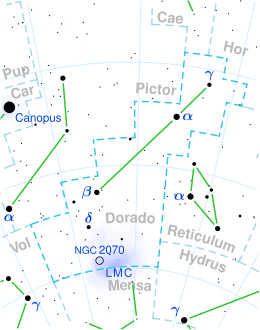Astronomy:Pi1 Doradus
| Observation data Epoch J2000.0 Equinox (celestial coordinates) | |
|---|---|
| Constellation | Dorado |
| Right ascension | 06h 22m 38.27576s[1] |
| Declination | −69° 59′ 02.5605″[1] |
| Apparent magnitude (V) | 5.54±0.01[2] |
| Characteristics | |
| Spectral type | K5 III[3] |
| U−B color index | +1.82[4] |
| B−V color index | +1.51[4] |
| Astrometry | |
| Radial velocity (Rv) | 15.7±2.9[5] km/s |
| Proper motion (μ) | RA: +26.170[1] mas/yr Dec.: +34.330[1] mas/yr |
| Parallax (π) | 4.9606 ± 0.0769[1] mas |
| Distance | 660 ± 10 ly (202 ± 3 pc) |
| Absolute magnitude (MV) | −0.83[6] |
| Details | |
| Mass | 1.67[7] M☉ |
| Radius | 56.5±2.9[8] R☉ |
| Luminosity | 530±12[9] L☉ |
| Surface gravity (log g) | 1.41[10] cgs |
| Temperature | 4,019+3−4[11] K |
| Metallicity [Fe/H] | +0.10[10] dex |
| Rotational velocity (v sin i) | 1.8±1.4[12] km/s |
| Age | 2.67[7] Gyr |
| Other designations | |
| Database references | |
| SIMBAD | data |
Pi1 Doradus, Latinized from π1 Doradus, is a solitary star[14] located in the southern constellation Dorado near the southwestern border with Mensa. It is faintly visible to the naked eye as an orange-hued point of light with an apparent magnitude of 5.54.[2] Gaia DR3 parallax measurements imply a distance of 660 light-years[1] and it is currently receding with a heliocentric radial velocity of 15.7 km/s.[5] At its current distance, Pi1 Doradus' brightness is diminished by 0.24 magnitudes due to interstellar extinction[15] and it has an absolute magnitude of −0.83.[6]
Pi1 Doradus has a stellar classification of K5 III,[3] indicating that it is an evolved K-type giant star. It has 1.67 times the mass of the Sun but at the age of 2.67 billion years,[7] it has expanded to 56.5 times the radius of the Sun.[8] It radiates 530 times the luminosity of the Sun[9] from its enlarged photosphere at an effective temperature 4,019 K[11] Gaia DR3 stellar evolution models give a larger radius of 63.2 R☉ and a higher luminosity of 938 L☉.[1] Pi1 Doradus is metal enriched with an iron abundance of [Fe/H] = +0.10 or 126% that of the Sun's.[10] Like many giant stars it spins slowly—having a projected rotational velocity of 1.8 km/s.[12]
References
- ↑ 1.0 1.1 1.2 1.3 1.4 1.5 Vallenari, A. et al. (2022). "Gaia Data Release 3. Summary of the content and survey properties". Astronomy & Astrophysics. doi:10.1051/0004-6361/202243940 Gaia DR3 record for this source at VizieR.
- ↑ 2.0 2.1 Høg, E.; Fabricius, C.; Makarov, V. V.; Urban, S.; Corbin, T.; Wycoff, G.; Bastian, U.; Schwekendiek, P. et al. (March 2000). "The Tycho-2 catalogue of the 2.5 million brightest stars". Astronomy and Astrophysics 355: L27–L30. ISSN 0004-6361. Bibcode: 2000A&A...355L..27H.
- ↑ 3.0 3.1 Houk, N.; Cowley, A. P. (1975). University of Michigan Catalogue of two-dimensional spectral types for the HD stars: Declinations −90° to −53°. 1. Bibcode: 1975mcts.book.....H.
- ↑ 4.0 4.1 Johnson, H. L.; Mitchell, R. I.; Iriarte, B.; Wisniewski, W. Z. (1966). "UBVRIJKL Photometry of the Bright Stars". Communications of the Lunar and Planetary Laboratory 4: 99–110. Bibcode: 1966CoLPL...4...99J.
- ↑ 5.0 5.1 Gontcharov, G. A. (November 2006). "Pulkovo Compilation of Radial Velocities for 35,495 Hipparcos stars in a common system". Astronomy Letters 32 (11): 759–771. doi:10.1134/S1063773706110065. ISSN 1063-7737. Bibcode: 2006AstL...32..759G.
- ↑ 6.0 6.1 Anderson, E.; Francis, Ch. (May 2012). "XHIP: An extended hipparcos compilation". Astronomy Letters 38 (5): 331–346. doi:10.1134/S1063773712050015. ISSN 1063-7737. Bibcode: 2012AstL...38..331A.
- ↑ 7.0 7.1 7.2 Bertelli, G.; Bressan, A.; Chiosi, C.; Fagotto, F.; Nasi, E. (August 1994). "Theoretical isochrones from models with new radiative opacities". Astronomy and Astrophysics Supplement Series 106: 275–302. ISSN 0365-0138. Bibcode: 1994A&AS..106..275B.
- ↑ 8.0 8.1 Kervella, P.; Thévenin, F.; Di Folco, E.; Ségransan, D. (April 8, 2004). "The angular sizes of dwarf stars and subgiants: Surface brightness relations calibrated by interferometry". Astronomy & Astrophysics 426 (1): 297–307. doi:10.1051/0004-6361:20035930. ISSN 0004-6361. Bibcode: 2004A&A...426..297K.
- ↑ 9.0 9.1 Brown, A. G. A. (August 2018). "Gaia Data Release 2: Summary of the contents and survey properties". Astronomy & Astrophysics 616: A1. doi:10.1051/0004-6361/201833051. Bibcode: 2018A&A...616A...1G. Gaia DR2 record for this source at VizieR.
- ↑ 10.0 10.1 10.2 Anders, F. et al. (August 2019). "Photo-astrometric distances, extinctions, and astrophysical parameters for Gaia DR2 stars brighter than G = 18". Astronomy & Astrophysics 628: A94. doi:10.1051/0004-6361/201935765. ISSN 0004-6361. Bibcode: 2019A&A...628A..94A.
- ↑ 11.0 11.1 Poggio, E.; Recio-Blanco, A.; Palicio, P. A.; Re Fiorentin, P.; de Laverny, P.; Drimmel, R.; Kordopatis, G.; Lattanzi, M. G. et al. (30 September 2022). "The chemical signature of the Galactic spiral arms revealed by Gaia DR3". Astronomy & Astrophysics 666: L4. doi:10.1051/0004-6361/202244361. ISSN 0004-6361. Bibcode: 2022A&A...666L...4P.
- ↑ 12.0 12.1 De Medeiros, J. R.; Alves, S.; Udry, S.; Andersen, J.; Nordström, B.; Mayor, M. (January 2014). "A catalog of rotational and radial velocities for evolved stars V: Southern stars *". Astronomy & Astrophysics 561: A126. doi:10.1051/0004-6361/201220762. ISSN 0004-6361. Bibcode: 2014A&A...561A.126D.
- ↑ "* pi.01 Dor". SIMBAD. Centre de données astronomiques de Strasbourg. http://simbad.u-strasbg.fr/simbad/sim-basic?Ident=%2A+pi.01+Dor.
- ↑ Eggleton, P. P.; Tokovinin, A. A. (11 September 2008). "A catalogue of multiplicity among bright stellar systems". Monthly Notices of the Royal Astronomical Society 389 (2): 869–879. doi:10.1111/j.1365-2966.2008.13596.x. ISSN 0035-8711. Bibcode: 2008MNRAS.389..869E.
- ↑ Gontcharov, George A.; Mosenkov, Aleksandr V. (28 September 2017). "Verifying reddening and extinction for Gaia DR1 TGAS main sequence stars". Monthly Notices of the Royal Astronomical Society 472 (4): 3805–3820. doi:10.1093/mnras/stx2219. ISSN 0035-8711. Bibcode: 2017MNRAS.472.3805G.
<ref> tag with name "Gould1879" defined in <references> is not used in prior text.
 |


